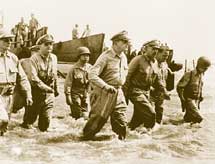War, Victory and the Bomb
The final battles in the Pacific were among the war's bloodiest. In June 1944, the Battle of the Philippine Sea effectively destroyed Japanese naval air power, forcing the resignation of Japanese Prime Minister Tojo. General Douglas MacArthur -- who had reluctantly left the Philippines two years before to escape Japanese capture -- returned to the islands in October. The accompanying Battle of Leyte Gulf, the largest naval engagement ever fought, was the final decisive defeat of the Japanese Navy. By February 1945, U.S. forces had taken Manila.

General Douglas MacArthur (center) had declared, "I shall return," when he escaped from advancing Japanese forces in the Philippines in 1942. Two years later, he made good on his promise and waded ashore at Leyte as U.S. forces began the liberation of the Philippines.
(The National Archives)
Next, the United States set its sight on the strategic island of Iwo Jima in the Bonin Islands, about halfway between the Marianas and Japan. The Japanese, trained to die fighting for the Emperor, made suicidal use of natural caves and rocky terrain. U.S. forces took the island by mid-March, but not before losing the lives of some 6,000 U.S. Marines. Nearly all the Japanese defenders perished. By now the United States was undertaking extensive air attacks on Japanese shipping and airfields and wave after wave of incendiary bombing attacks against Japanese cities.
At Okinawa (April 1-June 21, 1945), the Americans met even fiercer resistance. With few of the defenders surrendering, the U.S. Army and Marines were forced to wage a war of annihilation. Waves of Kamikaze suicide planes pounded the offshore Allied fleet, inflicting more damage than at Leyte Gulf. Japan lost 90-100,000 troops and probably as many Okinawian civilians. U.S. losses were more than 11,000 killed and nearly 34,000 wounded. Most Americans saw the fighting as a preview of what they would face in a planned invasion of Japan.
The heads of the U.S., British, and Soviet governments met at Potsdam, a suburb outside Berlin, from July 17 to August 2, 1945, to discuss operations against Japan, the peace settlement in Europe, and a policy for the future of Germany. Perhaps presaging the coming end of the alliance, they had no trouble on vague matters of principle or the practical issues of military occupation, but reached no agreement on many tangible issues, including reparations.
The day before the Potsdam Conference began, U.S. nuclear scientists engaged in the secret Manhattan Project exploded an atomic bomb near Alamogordo, New Mexico. The test was the culmination of three years of intensive research in laboratories across the United States. It lay behind the Potsdam Declaration, issued on July 26 by the United States and Britain, promising that Japan would neither be destroyed nor enslaved if it surrendered. If Japan continued the war, however, it would meet "prompt and utter destruction." President Truman, calculating that an atomic bomb might be used to gain Japan's surrender more quickly and with fewer casualties than an invasion of the mainland, ordered that the bomb be used if the Japanese did not surrender by August 3.
A committee of U.S. military and political officials and scientists had considered the question of targets for the new weapon. Secretary of War Henry L. Stimson argued successfully that Kyoto, Japan's ancient capital and a repository of many national and religious treasures, be taken out of consideration. Hiroshima, a center of war industries and military operations, became the first objective.
On August 6, a U.S. plane, the Enola Gay, dropped an atomic bomb on the city of Hiroshima. On August 9, a second atomic bomb was dropped, this time on Nagasaki. The bombs destroyed large sections of both cities, with massive loss of life. On August 8, the USSR declared war on Japan and attacked Japanese forces in Manchuria. On August 14, Japan agreed to the terms set at Potsdam. On September 2, 1945, Japan formally surrendered. Americans were relieved that the bomb hastened the end of the war. The realization of the full implications of nuclear weapons' awesome destructiveness would come later.
Within a month, on October 24, the United Nations came into existence following the meeting of representatives of 50 nations in San Francisco, California. The constitution they drafted outlined a world organization in which international differences could be discussed peacefully and common cause made against hunger and disease. In contrast to its rejection of U.S. membership in the League of Nations after World War I, the U.S. Senate promptly ratified the U.N. Charter by an 89 to 2 vote. This action confirmed the end of the spirit of isolationism as a dominating element in American foreign policy.
In November 1945 at Nuremberg, Germany, the criminal trials of 22 Nazi leaders, provided for at Potsdam, took place. Before a group of distinguished jurists from Britain, France, the Soviet Union, and the United States, the Nazis were accused not only of plotting and waging aggressive war but also of violating the laws of war and of humanity in the systematic genocide, known as the Holocaust, of European Jews and other peoples. The trials lasted more than 10 months. Twenty-two defendants were convicted, 12 of them sentenced to death. Similar proceedings would be held against Japanese war leaders.
